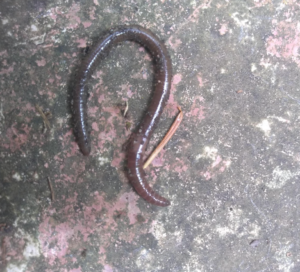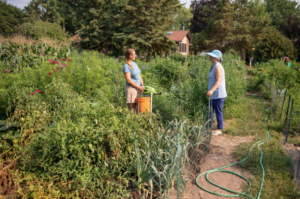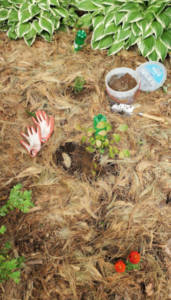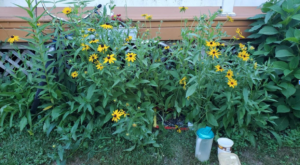By Angela Gupta, UMN Extension Forester
In October 2018, I found jumping worms in my vegetable garden two days after attending a professional conference and participating in a whole afternoon dedicated to jumping worms. It was saddening and disheartening, a bit hopeless. There weren’t many jumping worms, but they were easily identifiable. A few weeks before, I learned that jumping worms were found at my local municipal yard waste site, where I’d gotten cheap, local compost for years. So this wasn’t exactly a surprise, but it felt like a blow to the gut. My yard was the first in my county to have confirmed jumping worms.

Jumping worm, Photo by Angela Gupta, University of Minnesota Extension
I now know that the stages of grief that followed my discovery of jumping worms are normal. However, at the time, it felt isolating and devastating. Denial was short-lived. I’d been teaching about worms for years, and after a whole afternoon learning about jumping worms, I felt confident. I quickly reported the jumping worms and received professional verification: I had jumping worms. Anger followed more slowly: Why me, the invasive species expert? Shouldn’t I know better? What did I do wrong? Bargaining came and went quickly. I knew there were no recommendations on managing them; it’s hard to bargain alone. Depression appeared as I struggled to understand what to do with my garden and yard. I stopped adding mulch and limited what I did in my landscape for about two years. During this time, I slowly gained acceptance, and even some sense of relief, about my yard’s new reality. After all, I couldn’t get jumping worms anymore, so the anticipatory grief was gone.
During those two years, from 2018 through 2020, I recognized these same emotions in the people who contacted me as a terrestrial invasive species expert. I wasn’t alone, but few folks, including myself, seemed aware (or were maybe ashamed) of these feelings.
In the spring of 2020, I launched a community science project to engage gardeners with jumping worms to track their management and tell me about it. Maybe we would find reasonable management approaches for jumping worms collectively. 2020 was also the first year of the pandemic; emotions and fear were running high throughout the world, and for many, learning they had jumping worms also led to heartache and tears, and some of those folks found me.

Most survey respondents were white, female, and middle-aged. Photo by Cory Ryan, University of Minnesota Extension
During the winter of 2020-2021, with the help of Minnesota Master Naturalist trainees, we did a literature review of the emotional impacts of jumping worms. It turns out there’s no literature about that so we broadened our scope to the emotional impacts of climate changes and found some peer-reviewed literature that could be applied to jumping worms. I then connected with some of my University of Minnesota colleagues and learned about: Solastalgia, the stress caused by environmental change. Serious leisure: Many people identify as serious gardeners, so jumping worms impact their self-image. And disenfranchised grief, the grief for the loss of something others may minimize or for which there aren’t cultural norms around ritualizing that grief. Many people who learn they have jumping worms grieve the perceived loss of their beloved landscape and the perceived loss of a beloved hobby. I started sharing this information with my volunteers and received a lot of gratitude.
This past winter, I asked those same jumping worm management volunteers to complete an emotions survey. Here’s what I learned: Jumping worms affected homeowners deeply, causing sadness, fear, panic, impatience and anger. Over half of respondents reported dreaming of jumping worms, and 19% cried because of them. Even stories and observations of jumping worms lead to anxiety, mourning, anger, hopelessness and motivation.

Experimenting with various types of jumping worm management while planting. Photo by Angela Gupta, University of Minnesota Extension
There is hope. Volunteers that actively experimented with different jumping worm management techniques reported a sharp increase in effort even when management takes money and time. Further, they reported less worry and increased confidence, greater attention to environmental change, and increased jumping worm outreach efforts. Finally, these volunteers have proven when using a variety of integrated pest management approaches, it is possible to reduce jumping worm populations and reduce the negative impacts of jumping worms in home landscapes.
If you have jumping worms: you are not alone. You can continue to garden but garden differently. You can create rituals to help manage your grief. For me, I decided to try and convert my established yard to natives. Hope and agency matter: I am hopeful that eventually, my native, diverse landscape will improve, and I am grateful that jumping worms gave me the push I needed to start working. I am also grateful that I feel empowered to continue to garden. I can improve my invasive species prevention methods and creatively manage my landscape. Mostly I’m delighted my garden and landscape still offer the nature-based health benefits of breaking a sweat outside by getting my hands dirty that it always did.

In 2021, at the end of the second growing season, this tiny, native prairie patch is without jumping worms, even though they were in this spot in 2018. Jumping worms have never been found in prairies. Photo by Angela Gupta, University of Minnesota Extension
Additional resource
Emotional support: For people with jumping worms, https://z.umn.edu/jumpingwormsemotionalsupport
Assessing the emotional toll of jumping worm damage: Survey results show there may be ways to mitigate negative environmental and emotional impacts, https://z.umn.edu/emotionaltollofjw
About the Author
Angela Gupta is a University of Minnesota Extension Professor of Forestry who specializes in terrestrial invasive species. She has done invasive species early detection education and outreach for about 15 years. Ms. Gupta is running a “Jumping worms: Report management” citizen science project to try and understand what management options might work for “jumpings.” Ms. Gupta earned a MA in Organizational Management from Spring Arbor University and a BS in Forestry from the University of Kentucky.
Feature photo of Brad Herrick of the University of Wisconsin, UW–MADISON ARBORETUM
***
Each author appearing herein retains original copyright. Right to reproduce or disseminate all material herein, including to Columbia University Library’s CAUSEWAY Project, is otherwise reserved by ELA. Please contact ELA for permission to reprint.
Mention of products is not intended to constitute endorsement. Opinions expressed in this newsletter article do not necessarily represent those of ELA’s directors, staff, or members.

